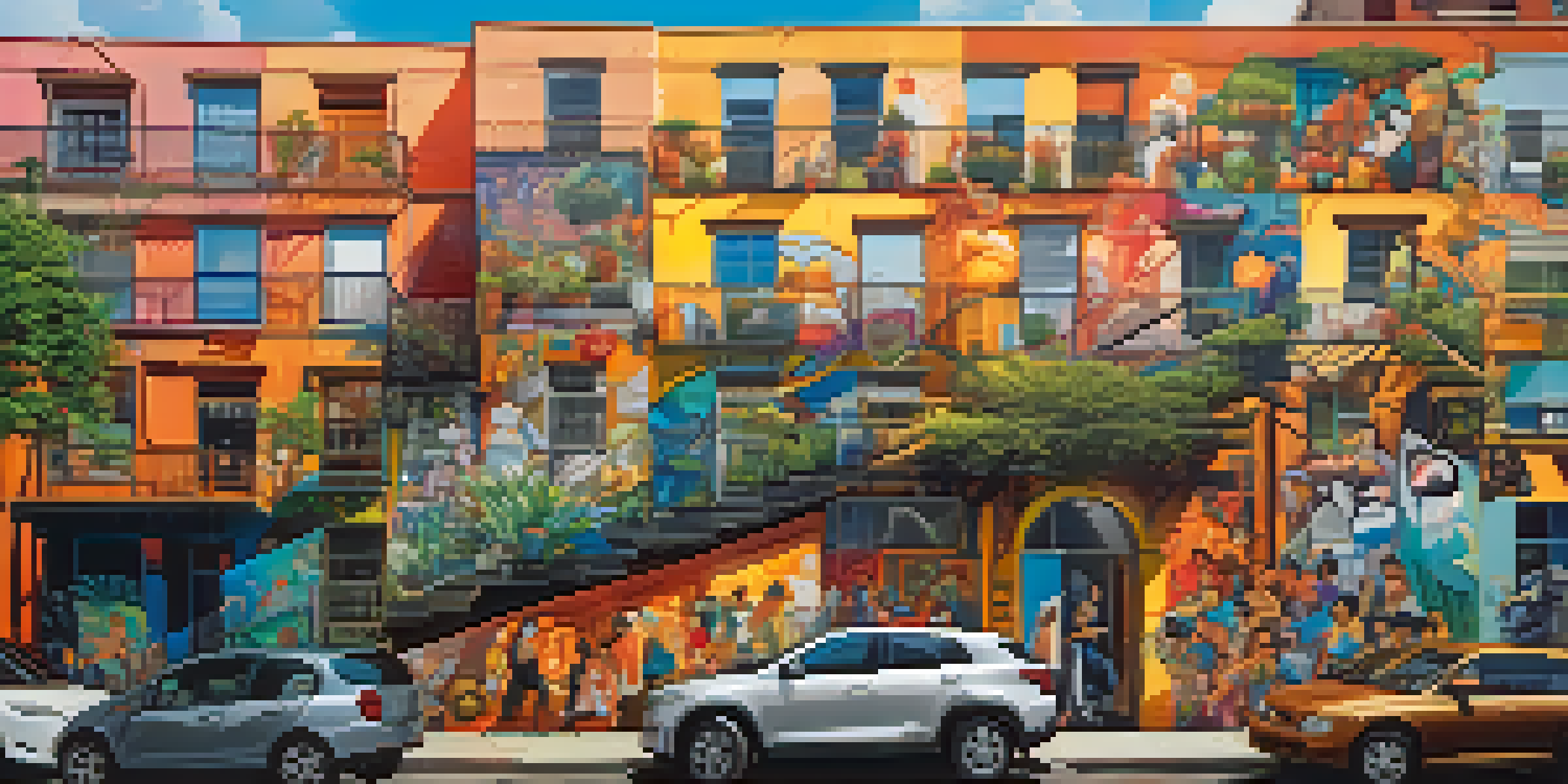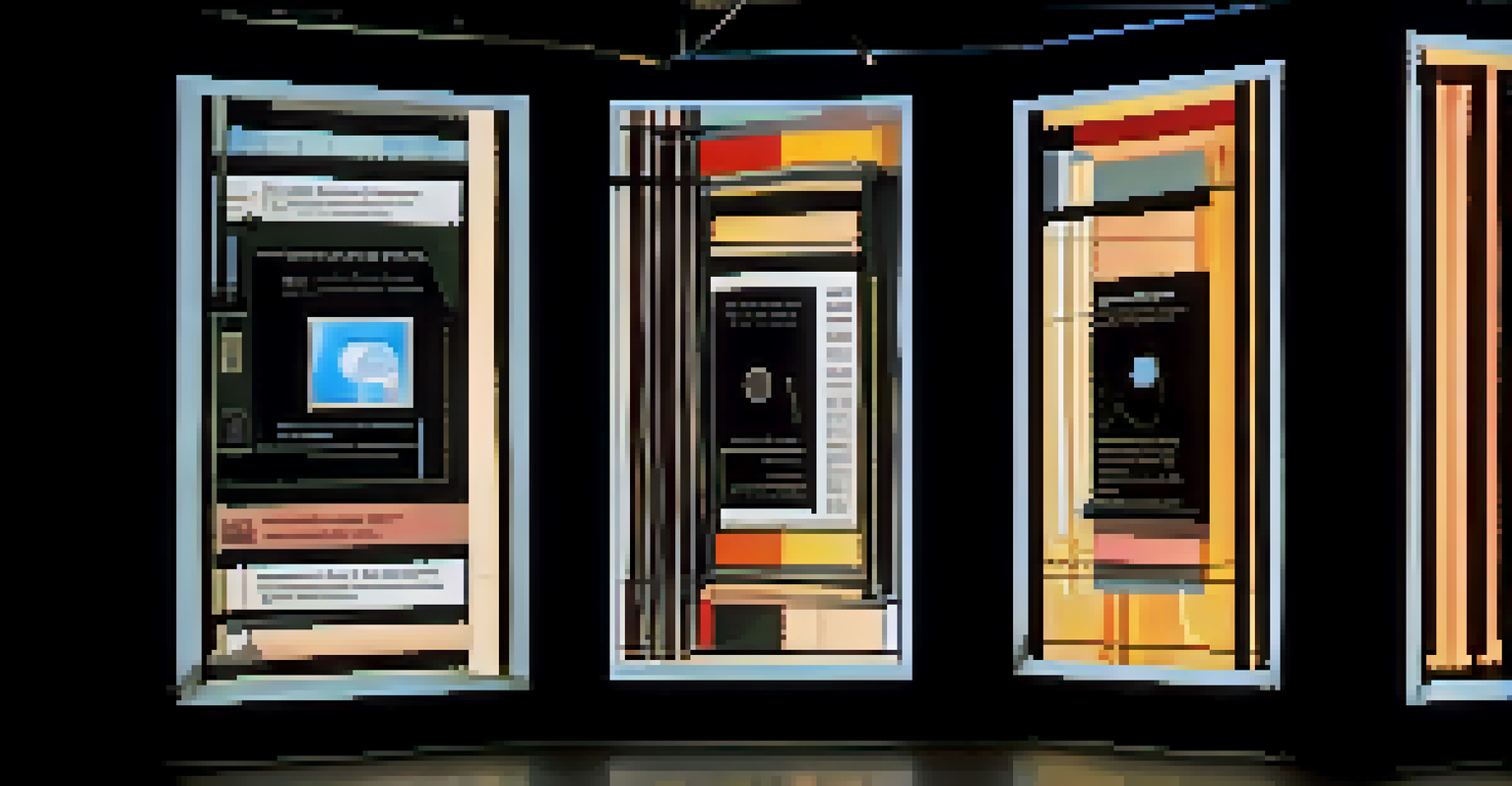Postmodernism: Questioning Truth and Authority in Art

Understanding Postmodernism and Its Origins
Postmodernism emerged as a response to the modernist movement, which championed objective truths and universal narratives. It began to take shape in the mid-20th century, influenced by a variety of cultural, political, and philosophical shifts. Artists and thinkers started questioning the very foundations of art, literature, and society, leading to a rich tapestry of ideas that reject absolute truths.
Postmodernism is not a style, but a way of thinking about the world.
At its core, postmodernism embraces plurality and ambiguity, encouraging us to see the world through a kaleidoscope of perspectives. This shift was marked by a growing recognition of the complexities of identity, culture, and history. By challenging established norms, postmodernism invites individuals to re-examine the narratives that shape their understanding of reality.
In essence, postmodernism is not just an art movement; it’s a philosophical lens that questions everything from authority to existence itself. This questioning spirit is what makes postmodern art so impactful and thought-provoking. This foundation sets the stage for deeper exploration into how truth and authority are portrayed and challenged in the art world.
The Role of Irony and Parody in Postmodern Art
Irony and parody are hallmark traits of postmodern art, allowing artists to playfully subvert traditional forms and meanings. By adopting these techniques, artists can highlight the absurdities and contradictions inherent in cultural narratives. For instance, a piece of artwork may mimic a classic style while simultaneously critiquing the very conventions it emulates.

This playful approach serves as a means of questioning established authority in the art world. Instead of revering the past, postmodern artists invite viewers to reconsider the significance of traditional forms. This creates a dynamic dialogue between the old and the new, leading audiences to reflect on how art influences and is influenced by society.
Postmodernism Challenges Absolute Truths
At its core, postmodernism encourages questioning established norms and embracing multiple perspectives on identity, culture, and history.
Through the lens of irony and parody, postmodern art becomes a vehicle for challenging societal norms and expectations. It encourages viewers to embrace ambiguity and question the way they perceive art and its purpose. Ultimately, this approach fosters a more inclusive understanding of artistic expression, allowing for diverse interpretations.
Deconstructing the Concept of 'High' Art
One of the key tenets of postmodernism is the deconstruction of the concept of 'high' art, which traditionally distinguished fine art from popular culture. Postmodern artists often blur these lines, merging elements of mass culture with fine art to create something new and provocative. This intersection challenges the elitist notions of what constitutes valuable art.
Art is a reflection of the society that creates it, and postmodern art reflects a society that questions its own truths.
For example, artists like Andy Warhol famously integrated commercial imagery into his work, transforming everyday objects into iconic pieces of art. By doing so, he questioned the prevailing attitudes towards originality and artistic merit. This democratization of art allows for a broader range of voices and experiences to be represented.
In this way, postmodernism not only reshapes the art landscape but also influences how we think about culture as a whole. It encourages us to appreciate the value of diverse art forms, regardless of their origins. As we embrace this shift, we open ourselves to a richer understanding of creativity and expression.
The Impact of Technology on Postmodern Art
Technology plays a crucial role in the evolution of postmodern art, providing new tools and mediums for artistic expression. From digital art to virtual reality installations, artists are exploring innovative ways to engage with their audiences. This technological influence not only transforms the creation of art but also shifts how it is experienced and understood.
The rise of the internet has democratized access to art, allowing artists to share their work with a global audience. This connectivity fosters collaboration and dialogue, breaking down traditional barriers between creators and consumers. As a result, postmodern art often reflects the complexities and challenges of living in a digital age.
Art as a Tool for Political Critique
Postmodern art often intersects with political discourse, allowing artists to critique power structures and provoke discussions about societal issues.
Moreover, technology raises questions about authenticity and originality in art. With the ability to replicate and share artworks instantly, the definition of what it means to be an artist is constantly evolving. This ongoing conversation about technology's role in art is a testament to the fluid nature of postmodernism itself.
Challenging Narratives of Identity in Postmodernism
Postmodernism also encourages a re-examination of identity, emphasizing that it is fluid and constructed rather than fixed. Artists explore themes of race, gender, sexuality, and class, often highlighting the complexities of individual experiences. This focus on diverse identities challenges the singular narratives that have dominated art history.
For instance, artists like Cindy Sherman use photography to explore the roles and stereotypes assigned to women in society. By presenting herself in various personas, she probes the boundaries of identity and representation. This approach invites viewers to question their own perceptions and assumptions about identity.
Through this lens, postmodern art becomes a powerful tool for social commentary, amplifying marginalized voices and stories. It encourages us to recognize the multiplicity of identities and the ways they intersect. In doing so, postmodernism not only enriches the artistic landscape but also promotes a deeper understanding of the human experience.
The Interplay Between Art and Political Discourse
Postmodernism often intersects with political discourse, as artists use their work to critique power structures and societal norms. By addressing current events and cultural issues, postmodern art serves as a response to the political climate. This engagement can take many forms, from overt political statements to subtle critiques embedded within the artwork.
For example, artists like Banksy utilize street art to challenge authority and provoke thought on social issues. By placing his art in public spaces, he invites discussion and reflection, making the political personal. This approach emphasizes the role of art as a catalyst for social change.
Embracing Ambiguity in Art
The legacy of postmodernism is characterized by its embrace of ambiguity, inviting diverse interpretations and enriching the viewer's experience.
In this way, postmodern art becomes an essential platform for voicing dissent and fostering dialogue about pressing issues. It blurs the lines between artist and activist, demonstrating that art can be a powerful means of advocacy. As viewers engage with these works, they are encouraged to contemplate their own roles in shaping society.
Embracing Ambiguity: The Legacy of Postmodernism
The legacy of postmodernism lies in its embrace of ambiguity and its refusal to settle for simple answers. This movement has fundamentally changed how we approach art, urging us to question our assumptions and engage with complexity. Instead of providing clear-cut messages, postmodern art often invites multiple interpretations, enriching the viewer's experience.
As we navigate an increasingly complex world, the principles of postmodernism continue to resonate. They encourage us to remain open to diverse perspectives and to challenge the status quo. This openness fosters a deeper appreciation for the nuances of art and culture, allowing us to appreciate the richness of human expression.

Ultimately, postmodernism's legacy is a call to remain curious and critical in our approach to art and life. By embracing uncertainty and questioning authority, we can cultivate a more inclusive and thoughtful society. This ongoing dialogue reflects the dynamic nature of art and its ability to evolve alongside us.